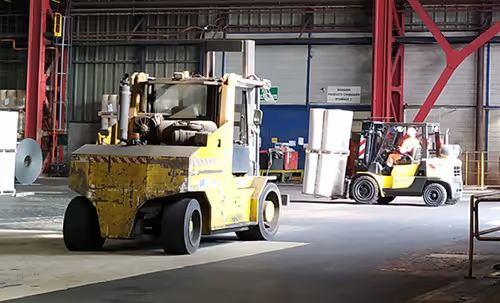Streamlining Production Visibility and Work Tracking
Introduction
AFL, a manufacturer of steel and metal components, faces significant challenges in managing its diverse range of products and production processes. With over 60,000 different SKUs and a median production run of only 10 units, AFL must efficiently manage its inventory, production scheduling, and workforce to meet customer demand and maintain competitiveness.

Problem Statement
AFL's production planning is hindered by the lack of visibility on the shop floor, leading to inefficiencies in locating work orders (DJ’s), tracking production status, and managing workforce productivity. Critical challenges include:
Visibility and Tracking: AFL struggles to locate DJ’s on the shop floor, leading to delays and duplicate production runs. Barcode scanning, while implemented, lacks consistency due to the wide variation in production processes.
Workforce Management: Worktime registration is inconsistent, with employees often unaccounted for during production hours. Supervisors face difficulties in tracking employee productivity and enforcing standard work procedures.
WIP Tracking: AFL lacks a reliable system to track work-in-progress (WIP) across production stages, resulting in uncertainty about order status and prioritization.
Impact
The inefficiencies in production visibility and workforce management have tangible impacts on AFL’s operations, including:
Time Loss: Significant time is wasted searching for DJ’s and managing missing or damaged paper work orders.
Production Delays: Inability to locate necessary components may result in ordering duplicate production runs, doubling production time and material costs.
Proposed Solution

To address these challenges, AFL proposes implementing the Pozyx tracking system in its US factory using tags linked to each DJ. Together with the local partner Gemba Systems, the solution was implemented. By the use of the Pozyx RTLS, all tags can be tracked with high accuracy in order to differentiate between the different production stages. To cover the entire area of over 10.000 square meters, at total of 85 anchors were installed.
Key features of the proposed solution include:
Tagged Job Jackets: Tags accompany each DJ, providing real-time visibility into production status and location. Tags are placed in job jackets and travel with the bin through production stages.
Zone-Based Tracking: Tags move through production zones, allowing managers to track order progress, time spent in each zone, and the number of bins in each area.
Worker Mobility: Workers carry smartphones with an app linked to AFL's Warehouse Management System (WMS) or Manufacturing Execution System (MES), enabling them to scan QR codes on tags for order information.
Benefits
The implementation of the tracking system offers several benefits to AFL:
Improved Visibility: Real-time tracking of DJ’s enhances production visibility, reducing time spent searching for orders and minimizing the risk of lost or duplicate work.
Enhanced Workforce Efficiency: Automated time tracking and standardized workflows improve workforce productivity and enable better resource allocation.
Streamlined Operations: By optimizing production workflows and WIP tracking, AFL can reduce lead times, improve order accuracy, and enhance overall operational efficiency.
Eric Borowicz, General Manager of AFL’s Accessories BU stated, “AFL chose the Pozyx RTLS system to track orders during all stages of production. The optimization of expedite orders is of key importance to meet customer expectations, deliver on time, and drive additional revenue. Before we implemented the Pozyx system, it was difficult for us to know the exact order status and location. During the Tennessee tornado outbreak, for example, we were able to use Pozyx to track over 70 high-priority orders and ensure each order was completed within two days. Having this level of visibility during emergency situations, helps us deliver products to our customers on time, so that critical infrastructure can be restored.”

Conclusion
By addressing the challenges of production visibility and workforce management through the implementation of a comprehensive tracking system, AFL can streamline its operations, improve customer satisfaction, and maintain competitiveness in the market. With a focus on technology integration, standardized processes, and employee training, AFL is poised to overcome its current limitations and achieve sustainable growth.
Looking to increase visibility for your production?
Look no further! Schedule a call with our experts to discuss your use-case, we are happy to help!







